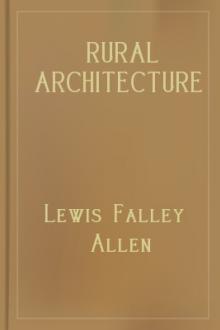Rural Architecture by Lewis Falley Allen (accelerated reader books .txt) 📖

- Author: Lewis Falley Allen
- Performer: -
Book online «Rural Architecture by Lewis Falley Allen (accelerated reader books .txt) 📖». Author Lewis Falley Allen
V. H. Hallock.
North-East Center, N.Y., April 2d, 1849.'"We have seen several of these rams at work; and in any place where the required amount of fall can be had, with sufficient water to supply the demand, we are entirely satisfied that no plan so cheap and efficient can be adopted, by which to throw it to a higher level, and at a distance from the point of its flow. We heartily commend it to all who need a thing of the kind, and have at hand the facilities in the way of a stream for its use.
It is hardly worth while to add, that by the aid of the ram, water can be thrown into every room in the dwelling house, as well as into the various buildings, and yards, and fields of the farm, wherever it may be required.
RAT-PROOF GRANARY.This plan, and description, we take from an agricultural periodical published in New York—"The Plow." We can recommend no plan of a better kind for the objects required. It is an old-fashioned structure, which many of our readers will recognize—only, that it is improved in some of its details.

GRANARY.
The illustration above needs but little description. The posts should be stone, if procurable, one foot square, and four feet long, set one-third in the ground, and capped with smooth flat stones, four to six inches thick, and two feet, at least, across. If wooden posts are used, make them sixteen inches square, and set them in a hole previously filled, six inches deep, with charcoal, or rubble stone and lime grouting, and fill around the posts with the same. Four inches from the top, nail on a flange of tin or sheet iron, six inches wide, the projecting edge of which may be serrated, as a further preventive against the depredating rascals creeping around. The steps are hinged to the door-sill, and should have a cord and weight attached to the door, so that whenever it is shut, the steps should be up also; this would prevent the possibility of carelessness in leaving them down for the rats to walk up. The sides should be made of slats, with large cracks between, and the floor under the corn-crib, with numerous open joints; no matter if shattered corn falls through, let the pigs and chickens have it; the circulation of the air through the pile of corn, will more than pay for all you will lose through the floor. If you intend to have sweet grain, be sure to have a ventilator in the roof, and you may see by the vane on the top of it, how the wind will always blow favorably for you.
IMPROVED DOMESTIC ANIMALS.Having completed the series of subjects which we had designed for this work, we are hardly content to send it out to the public, without inviting the attention of our farmers, and others who dwell in the country and occupy land, to the importance of surrounding themselves with the best breeds of domestic animals, as an item of increased profit in their farm management, and as a subject of interest and satisfaction to themselves in the embellishment of their grounds.
We have addressed ourselves through these pages to the good sense of men who, in their general character and pursuits, comprise the most stable class of our population. We have endeavored to impress upon them the importance of providing all the conveniences and comforts to themselves, in their dwellings, as well as the due provision for their animals and crops, in the rougher farm buildings, which their circumstances will admit; and we trust they have been shown that it is proper economy so to do. We have, in addition to these, somewhat dilated upon objects of embellishment, in the way of grounds to surround them, and trees to beautify them, which will in no way interfere with a just economy, and add greatly to the pleasure and interest of their occupation. We now want them to introduce into those grounds such domestic animals as shall add to their ornament, and be far more profitable to themselves, than the inferior things which are called the common, or native stock of the country. Without this last lesson, half our object would be lost. Of what avail will be the best provision for the conveniences of a family, and the labors of the farm, if the farm be badly cultivated, and a worthless or inferior stock be kept upon it? The work is but half done at best; and the inferiority of the last will only become more conspicuous and contemptible, in contrast with the superior condition of the first.
It is not intended to go into an examination of the farm-stock of our country at large, nor into their modes of treatment; but, to recommend such varieties of animals as are profitable in their breeding and keeping, both to the professional farmer in his vocation, and to such as, beyond this, find them an object of convenience, or of pleasure.
We, in America, are comparatively a young people. Yet, we have surmounted necessity. We have arrived at the period when we enjoy the fruits of competence—some of us, the luxuries of wealth. A taste for superior domestic animals has been increasing, and spreading over the United States for many years past; so that now, a portion of our farmers and country people understand somewhat of the subject. It has been thoroughly demonstrated, that good farm stock is better, and more profitable than poor stock. Still, a taste for good stock, and the advantages of keeping them, over the common stock of the country, is not generally understood; and that taste has to be cultivated. It is not altogether a thing of nature, any more than other faculties which require the aid of education to develope. We have known many people who had a fine perception in many things: an eye for a fine house, pleasant grounds, beautiful trees, and all the surroundings which such a place might command; and when these were complete, would place about it the veriest brutes, in the way of domestic animals, imaginable. The resident of the city, who lives at his country-house in summer, and selects a picture of mean or inferior quality, to hang up in his house by way of ornament, would be laughed at by his friends; yet he may drive into his grounds the meanest possible creature, in the shape of a cow, a pig, or a sheep, and it is all very well—for neither he nor they know any better; yet, the one is quite as much out of place as the other. The man, too, who, in good circumstances, will keep and drive a miserable horse, is the ridicule of his neighbors, because everybody knows what a good horse is, and that he should be well kept. Yet, the other stock on his farm may be the meanest trash in existence, and it creates no remark. On the contrary, one who at any extra cost has supplied himself with stock of the choicer kinds, let their superiority be ever so apparent, has often been the subject of ribaldry, by his unthinking associates. And such, we are sorry to say, is still the case in too many sections of our country. But, on the whole, both our public spirit, and our intelligence, is increasing, in such things.
Now, we hold it to be a practical fact, that no farm, or country place, can be complete in its appointments, without good stock upon it; and it is useless for any one to suppose that his farm, or his place, is finished, without it. The man who has a fine lawn, of any extent, about his house, or a park adjoining, should have something to graze it—for he cannot afford to let it lie idle; nor is it worth while, even if he can afford it, to be mowing the grass in it every fortnight during the summer, to make it sightly. Besides this, grass will grow under the trees, and that too thin, and short, for cutting. This ground must, of course, be pastured. Now, will he go and get a parcel of mean scrubs of cattle, or sheep, to graze it, surrounding his very door, and disgracing him by their vulgar, plebeian looks, and yielding him no return, in either milk, beef, mutton, or wool? Of course not, if he be a wise, or a provident man, or one who has any true taste in such matters. He will rather go and obtain the best stock he can get, of breeds suited to the climate, and soil, which will give him a profitable return, either in milk, or flesh, or their increase, for his outlay; and which will also embellish his grounds, and create an interest in his family for their care, and arrest the attention of those who visit him, or pass by his grounds. Of the proper selection of this branch of his stock, we shall now discourse.
(349)
(350)

(351)
(352)

In cattle, if your grounds be rich, and your grass abundant, the short-horns are the stock for them. They are "the head and front," in appearance, size, and combination of good qualities—the very aristocracy of all neat cattle. A well-bred, and well developed short-horn cow, full in the qualities which belong to her character, is the very perfection of her kind. Her large, square form; fine orange, russet, or nut-colored muzzle; bright, prominent, yet mild, expressive eye; small, light horn; thin ears; clean neck; projecting brisket; deep, and broad chest; level back, and loin; broad hips; large, and well-spread udder, with its silky covering of hair, and clean, taper, wide-standing teats, giving twenty to thirty quarts of rich milk in a day; deep thigh, and twist; light tail; small, short legs; and, added to this, her





Comments (0)